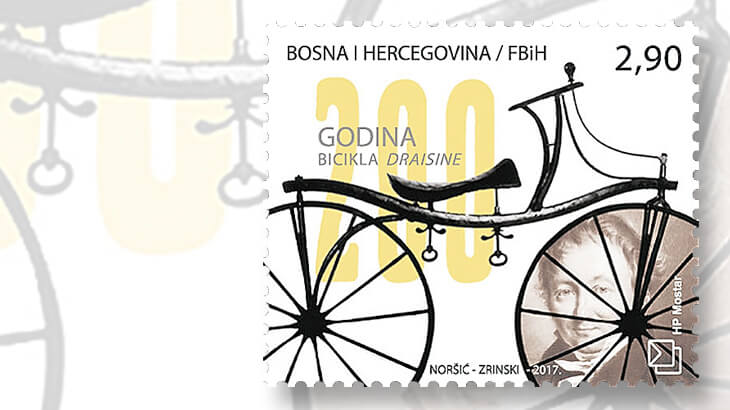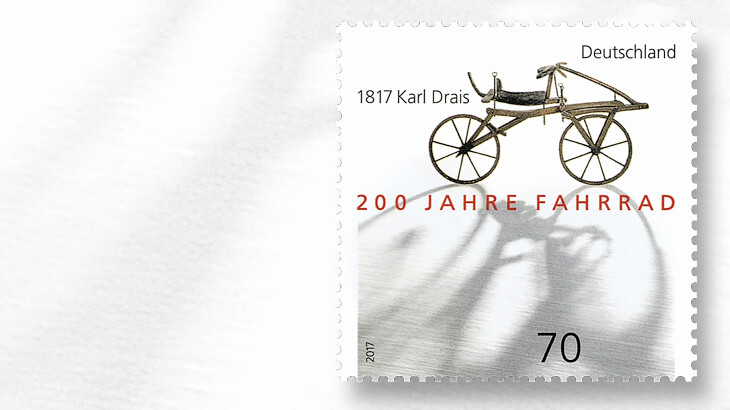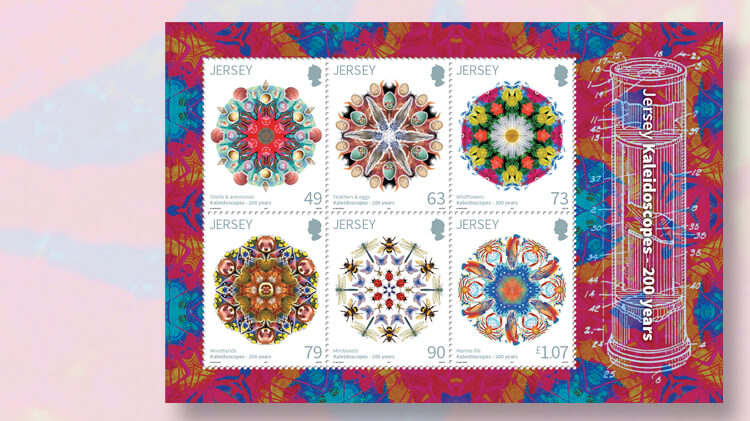World Stamps
Stamps celebrate bicentennials of cement, the bicycle, and the kaleidoscope
By Denise McCarty
Recent stamps celebrate the 200th anniversaries of three inventions: artificial cement, a forerunner of the bicycle, and the kaleidoscope.
Cement
A €1.30 French stamp issued June 6 is inscribed “1817 - Invention Du Ciment Artificial,” which translates to invention of artificial cement.
This stamp pictures Louis Vicat (1786-1861) in the foreground and the Souillac Bridge over the Dordogne River in the background.
Connect with Linn’s Stamp News:
Sign up for our newsletter
Like us on Facebook
Follow us on Twitter
Vicat, the cement and concrete company founded in 1853 by Vicat's son Joseph, tells the story of this invention:
“As a young graduate of France’s Polytechnique and Ponts et Chaussees engineering schools, Louis Vicat was appointed in 1812 to build a new bridge over the Dordogne River, whose torrential flow conditions called for some special techniques. Driven by the need to build a robust bridge at the lowest possible cost, Vicat devoted all his time to research, culminating in 1817 with the discovery of the principles underlying the manufacture of artificial lime and cement.
“Souillac Bridge thus became thus became the first to have foundations made from artificial cement.”
The bridge was completed in 1824.
Vicat’s invention was authenticated by the French Academy of Sciences in 1818, but he never obtained a patent for it.
Florence Gendre designed the French stamp, and Philaposte printed it by gravure.
Bicycle
New stamps from Germany, Bosnia and Herzegovina (Croat Administration) and Switzerland commemorate the 200th anniversary of Karl Drais’ two-wheeled vehicle, the laufmaschine (running machine).
Drais was born in Baden in 1785, and the Baden-Wurttemberg Ministry of Transport has devoted a website to the laufmaschine’s bicentennial.
The site explains how necessity led to this invention:
“1816 was the year without a summer. The reason was the eruption of the Tambora volcano in what is now Indonesia. This had dire consequences for Europe’s climate, bringing low temperatures, hail, endless downpours and floods. Failed harvests, famine and massive increases in food prices followed, and the scarcity of animal feed led to the death of huge numbers of horses.“
“This desperate situation led a man called Karl Friedrich Drais (1785-1851) who was born in Karlsruhe to invent the ‘draisine’ or dandy horse in 1817, the prototype of the modern bicycle. Like children’s balance bikes today, this original design had no pedals and it was simply pushed forward by the rider’s legs. A comfortable saddle and moveable handlebars helped to maintain balance.”
The 70¢ German stamp, issued July 13, depicts Drais’ invention. Rudolf Gruttner and Sabine Matthes designed this commemorative, and Bagel Security-Print printed it by offset in panes of 10.
Drais took his bicycle out for his first public ride on June 12, 1817, and Bosnia and Herzegovina (Croat Administration) issued its 2.90-mark commemorative exactly 200 years later.
Designer Ariana Norsic placed Drais’ portrait inside the front wheel of his laufmaschine on this stamp. Zrinski printed the stamp by offset in panes of nine.
Two 1-franc Swiss stamps issued March 1 honor the 200th anniversary of the bicycle. One depicts the draisine, and the other shows a modern bicycle.
Vaudeville Studios designed the Swiss stamps, and Cartor printed them by offset in sheets of 20.
Kaleidoscope
Six stamps from Jersey not only honor the invention of the kaleidoscope, they also feature flora and fauna of this Channel island in kaleidoscopic patterns.
Jersey Post issued the stamps July 10.
Melanie Gouzinis, head of philately at Jersey Post, said, “As Jersey has such an amazing abundance of wildlife, we took the opportunity to showcase different aspects in a unique and interesting way, whilst commemorating the fascinating work of David Brewster, inventor of the kaleidoscope.”
An inscription on each stamp provides a clue as to what is shown. For example, the 49-penny stamp is inscribed “shells & anemones.”
The other stamps are inscribed: “feathers & eggs,” 63p; “wildflowers,” 73p; “woodlands,” 79p; “minibeasts” (insects and a spider), 90p; and “marine life,” £1.07.
Brewster (1781-1868), a Scottish physicist, actually invented the kaleidoscope in 1816. The 200th anniversary refers to the year it was patented, 1817.
The Brewster Kaleidoscope Society mentions his many other interests: “He was a man with as many facets as his invention. Whether delving into scientific research, religion, philosophy, education, optics, photography, writing, inventions, or life on other planets, Sir David pursued each endeavor with incredible energy.”
Mark Wilkinson designed the stamps. Cartor printed them by offset in panes of 10 with kaleidoscopic designs in the selvage, and in a souvenir sheet with the six stamps se-tenant.
Medical inventions
New stamps of Mexico, Belgium and Spain honor inventions and innovations related to health and medicine.
On World Intellectual Property Day, April 26, Mexico issued a se-tenant pair of stamps featuring various inventions, including a scorpion anti-venom developed by Alejandro Alagon Cano. He also has created anti-venoms for snake and spider bites.
Among the medical advances recognized on a pane of five issued June 12 by Belgium is the invention of mosquito repellent by Alfons Vandoninck.
Spain’s philatelic tribute to the decade of the 1970s includes a stamp commemorating the 1973 invention of the disposable syringe by Manuel Jalon Corominas.
Issued July 10, this souvenir sheet of four also salutes the discovery of fiber optics.
MORE RELATED ARTICLES
Headlines
-
US Stamps
Oct 7, 2024, 3 PMMcMurtrie dismissed as APS education director following Sept. 21 arrest
-
US Stamps
Oct 7, 2024, 12 PMVasiliauskas named president of Mystic Stamp Co.
-
US Stamps
Oct 6, 2024, 5 PMApgar souvenir card available
-
US Stamps
Oct 6, 2024, 4 PMFirst Continental Congress and U.N. stamps receive Scott catalog numbers












